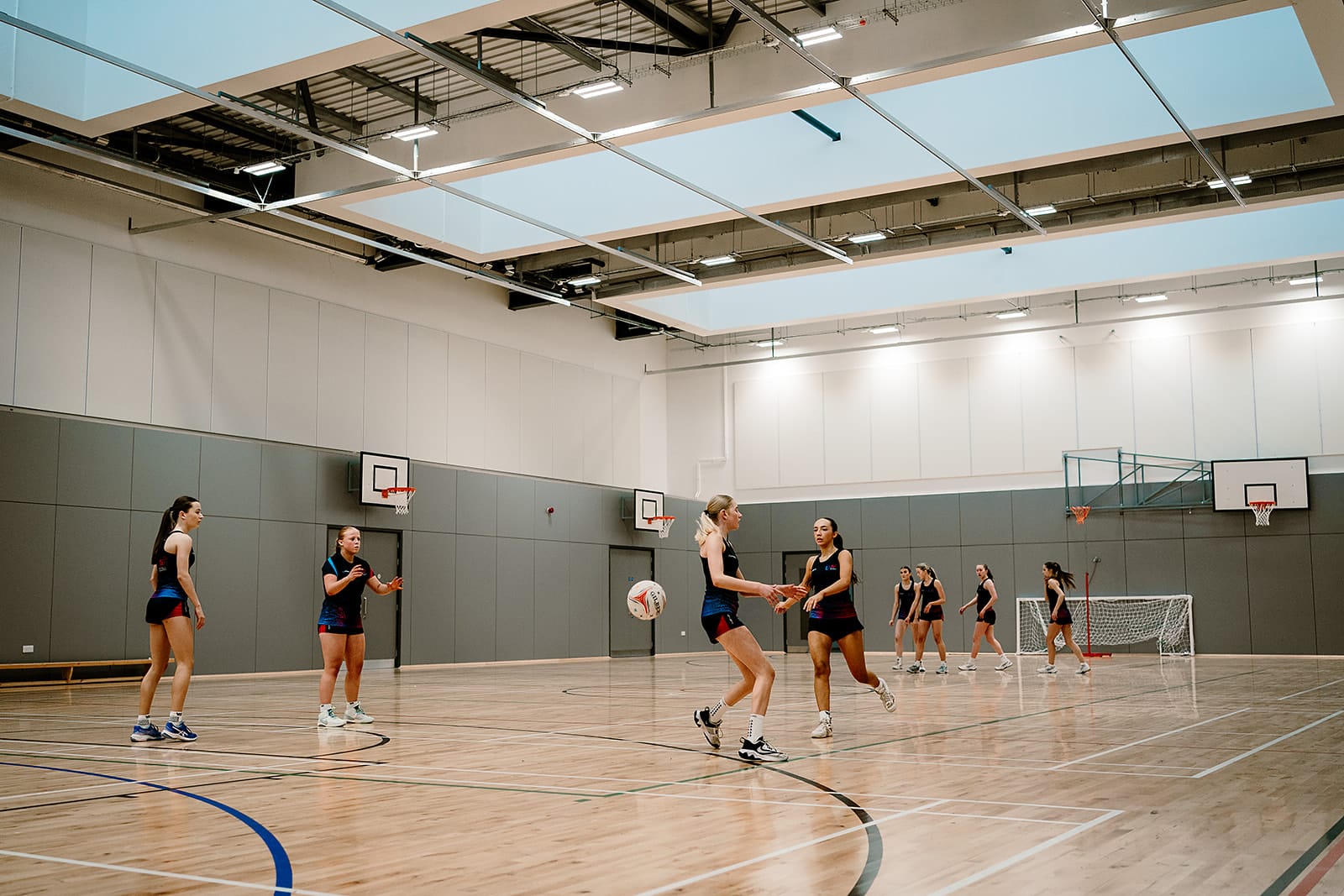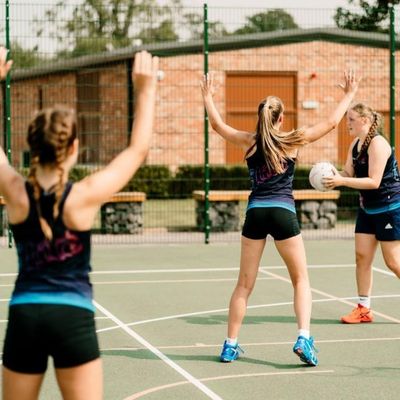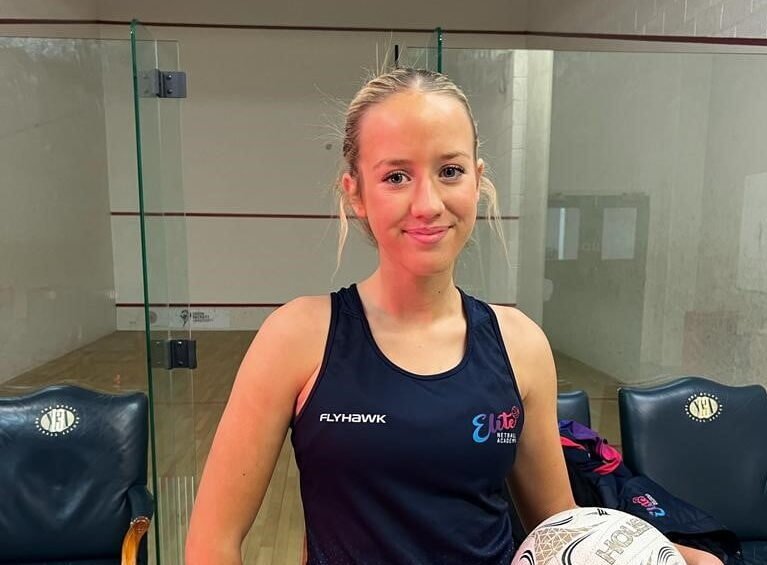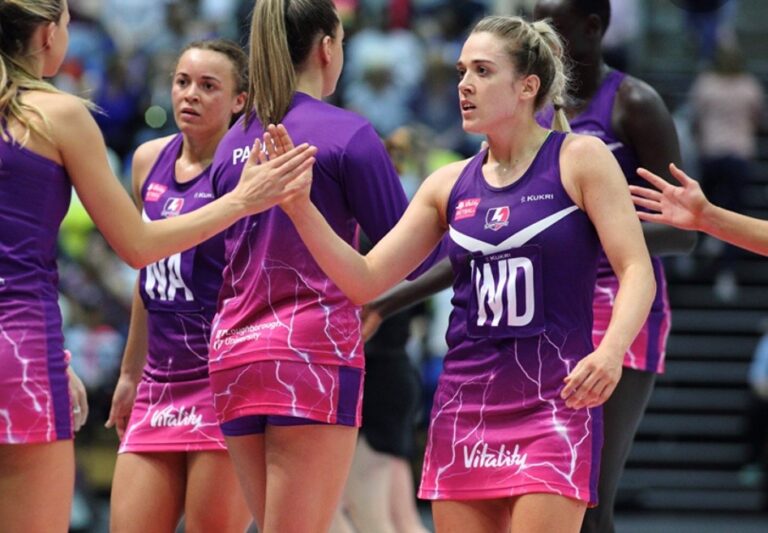Defending in Netball
Head up, arms down and feet moving! It’s time to look at defending in netball.
In this article on defending in netball, we look at:
- Principles of defencing
- Coaching points for defending in netball
- Types of defence in netball
- Split circle defence
- V defence
- Diamond defence
- 1 v 1 defence
- How to communicate in netball
- Rules for blocking in netball
- Qualities of teams that defend well
- Why everyone on court is a defender
The Principles of Defending in Netball
There are four key principles to defending in netball. These principles are then supported by three stages and players can shift between all three throughout a game or might choose to stick to one style.
Principles of defending:
- Getting ball side
- Keeping weight balanced
- Dictating the space and challenging the ball
- Communicating with teammates
Players can then decide how they defend, this is often taught in 3 stages:
- Marking the player
- Marking the ball
- Marking the space
Coaching points for Defending in netball
Below are ten key areas coaches should focus on during defensive coaching sessions:
- Players should keep their feet shoulder-width apart
- Knees slightly bent, upright stance
- Angled body position at the side of the attacker
- Head and eye up to see players and the ball at all times
- Arms down and close to their side
- Shadow the attacker and run into the space to challenge ball
- Try not to turn your head, move your feet fast to keep your body facing the ball
- Always try to challenge the ball with two hands
- Run onto the ball
- Ensure players are communicating with one another
It goes without saying that coaching a player to think of all ten points for defending in netball comes with time and practice so start by asking your players to add in one ingredient at a time.
Types of defence in netball
Here are some popular types of defence in netball. The type of defensive formation you choose will depend on the abilities of your players and the style of the team you play against.
Split circle defence
The aim is to set up the intercept for your defensive partner. In split circle defence players work as a pair and each play a side of the circle.
For example, defender one would always be ball side. Their purpose is to stop a short feed into the circle from the mid-court. So they are slightly in front of the other defender on a side angle.
Defender two is also ball side but on the other side of the post. Protecting the space around the post and forcing the shooter further away from it. This positioning often forces a high, cross-court feed or swing to the other mid-court player on the far side of the circle. This ball could be challenged by the back defender.
For split circle defence to be successful players need to:
Stay loose on the attacker’s body. Positioning slightly off the body to make the space look open to tempt the mid-court into feeding the ball. This gives the defender more room to challenge and does not give away penalties.
If the ball does swing across to the other mid courter. The defenders switch roles. Always stopping the ball side quick pass by being slightly in front of the movement.
V defence
In netball, “V” defence is a defensive technique where two players work together to shut down an attacking player and create opportunities for turnovers. You’re aiming to restrict the driving player’s space and force them back up the court, as well as creating an opportunity for a tip or intercept.
The “V” can be used anywhere on the court, but it’s often easier to start players in a smaller space. Practice a tighter “V” on the court first when coaching the skill and then once players feel confident and are having success you can build players into using a wider “V.”
Most players will use the “V” If a teammate is beaten, the “V” defence allows defensive players to cover a long drive as a unit. A player can drop on the attackers drive to challenge or dictate and the defensive players switch attackers to keep pressure on the ball.
For “V” defence to be successful players need to:
Effective and early communication will make the “V” even more successful. We’ve got a great “V” Defence Drills session in our Member’s Area. NSL Assistant Coach and Defence Specialist Maggie Birkinshaw put this coaching video together for us and it clearly shows how “V” Defence works
Not a member? Join today to access 100’s of coaching resources for just £50 a year – click here
Diamond defence
Diamond defence, (also referred to as zone defence) in netball is a defensive strategy where the entire team marks the space instead of individual players marking individual opponents. This makes it difficult for the opposing team to see space, which can force them into unforced errors or held balls. When the ball or a player enters a defender’s space, it’s their responsibility to intercept or slow down play in that area.
For diamond/zone defence to be successful players need to:
- Adjust positioning – players should shift and adjust their formation based on the ball’s location.
- Intercept – once players maintain their shape and structure they can look to play onto any balls around their area.
- Communication – ensure players are committed to the zone and talk through it to help each other maintain the shape.
1 v 1 defence
This style of defence helps to confine and control players. Defender should position themselves slightly behind their attacker so that they can track their movement around the court. The defender wants to have their back to the GK in the circle. If the defender is behind the attacker they can angle to force the attacker to or away from the ball. They do this by stepping up and setting up an angle early to deny space and dictate attacker’s movement after they have passed the ball.
Keep concentration and be ready to run into any space the attacker wants to go using your body. Try and preempt the space they want to attack and control where they can go.
For 1 v1 defence to be successful players need to:
- Shadowing and denying space – defenders should be ready to react to the attacker’s movements and guide them into uncomfortable positions.
- Pressure – defenders should make things difficult for the opposition by staying within three feet of them. Giving away a penalty will relieve pressure on the attacking team and let them reset.
- Shut down opponents – by forcing them into disadvantageous positions near the sideline or in their defensive third. This can lead to errors or passes that defenders can challenge.
How to communicate in netball
Communication needs to be clear and loud. However, not every player is as comfortable communicating loudly, so as coaches look to encourage small improvements each time you complete defensive drills. If you see a player communicate during the drills make sure you praise them.
Top tip to improve communication in netball – get the defenders to work in pairs and the defender who is ball side has to listen and move in the direction the back defender says. They have to stay facing forwards and resist the urge to turn their head. They have to trust the player behind them.
Effective communication on the court keeps teams connected as units.
Our tried and tested drills featured in the “Communication in defence” video on the Member’s Area are great fun drills to get your team talking!
What are the rules for blocking in netball?
In netball, blocking is allowed if it doesn’t obstruct or intimidate the other team. Here are some blocking rules in netball:
- Distance: Players must be at least 3 feet (0.9 m) away from a player with the ball when defending. Arms cannot be raised until the player’s feet are 3 feet away from their opponent.
- Pushing: Players can’t push their opponents off the line to block or zone them.
- Moving into the path: Players can’t move into the path of a moving player and cause contact. A defender can move into the path of the player as long as the attacking player has time to change direction or stop.
- Marking: Players can’t mark a player with their arms out. Arms must be kept down by your sides, holding the bottom of your skirt or shorts can help.
Qualities of netball teams that defend well
Defending and building pressure is hard work. You have to be persistent and disciplined – some of the greatest defensive teams work so well due to this, they are relentless and work as units.
Great defensive teams are:
- Selfless and have a relentless work rate
- Committed
- Intense
Why all players on court are defenders
Pressure builds through the team from GS to GK applying defensive intensity. If teams only expect the GK, GD and WD to intercept the ball or force a turnover then they’re making it an extremely difficult job for their teammates.
In through-court defence, every player is involved. The earlier the interception the better. Teams can thrive and lift off this while working together as a team. All players should know all defensive set-ups and their role within a set-up so when communicated they can adapt through the game together and adjust accordingly.
Our amazing FIVE-PART DEFENCE SERIES WITH NSL ASSISTANT COACH AND DEFENCE SPECIALIST MAGGIE BIRKINSHAW IS NOW AVAILABLE iN OUR MEMBER’S AREA – HOME TO 100’s OF COACHING RESOURCES
The five defensive coaching videos are:
- Communication in Defence
- V Defence
- Diamond Defence
- Confine and Control
- Split Circle Defence
WATCH NOW
Join now












